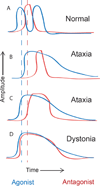Physiologic changes associated with cerebellar dystonia
- PMID: 24879387
- PMCID: PMC4156890
- DOI: 10.1007/s12311-014-0572-5
Physiologic changes associated with cerebellar dystonia
Abstract
Dystonia is a neurologic disorder characterized by sustained involuntary muscle contractions. Lesions responsible for unilateral secondary dystonia are confined to the putamen, caudate, globus pallidus, and thalamus. Dysfunction of these structures is suspected to play a role in both primary and secondary dystonia. Recent evidence has suggested that the cerebellum may play a role in the pathophysiology of dystonia. The role of the cerebellum in ataxia, a disorder of motor incoordination is well established. How may the cerebellum contribute to two apparently very different movement disorders? This review will discuss the idea of whether in some cases, ataxia and dystonia lie in the same clinical spectrum and whether graded perturbations in cerebellar function may explain a similar causative role for the cerebellum in these two different motor disorders. The review also proposes a model for cerebellar dystonia based on the available animal models of this disorder.
Conflict of interest statement
I have no relevant conflicts of interest to declare.
Figures


Similar articles
-
The basal ganglia and cerebellum interact in the expression of dystonic movement.Brain. 2008 Sep;131(Pt 9):2499-509. doi: 10.1093/brain/awn168. Epub 2008 Jul 26. Brain. 2008. PMID: 18669484 Free PMC article.
-
Network-level connectivity is a critical feature distinguishing dystonic tremor and essential tremor.Brain. 2019 Jun 1;142(6):1644-1659. doi: 10.1093/brain/awz085. Brain. 2019. PMID: 30957839 Free PMC article.
-
Current Opinions and Areas of Consensus on the Role of the Cerebellum in Dystonia.Cerebellum. 2017 Apr;16(2):577-594. doi: 10.1007/s12311-016-0825-6. Cerebellum. 2017. PMID: 27734238 Free PMC article.
-
Dissecting the links between cerebellum and dystonia.Cerebellum. 2014 Dec;13(6):666-8. doi: 10.1007/s12311-014-0601-4. Cerebellum. 2014. PMID: 25239288
-
Dystonia as a network disorder: what is the role of the cerebellum?Neuroscience. 2014 Feb 28;260:23-35. doi: 10.1016/j.neuroscience.2013.11.062. Epub 2013 Dec 11. Neuroscience. 2014. PMID: 24333801 Free PMC article. Review.
Cited by
-
Multimodal Imaging in a Patient with Hemidystonia Responsive to GPi Deep Brain Stimulation.Case Rep Neurol Med. 2017;2017:9653520. doi: 10.1155/2017/9653520. Epub 2017 Jul 4. Case Rep Neurol Med. 2017. PMID: 28744382 Free PMC article.
-
The basal ganglia and the cerebellum: nodes in an integrated network.Nat Rev Neurosci. 2018 Jun;19(6):338-350. doi: 10.1038/s41583-018-0002-7. Nat Rev Neurosci. 2018. PMID: 29643480 Free PMC article. Review.
-
Cerebellum: An explanation for dystonia?Cerebellum Ataxias. 2017 May 12;4:6. doi: 10.1186/s40673-017-0064-8. eCollection 2017. Cerebellum Ataxias. 2017. PMID: 28515949 Free PMC article. Review.
-
The pathogenesis of blepharospasm.Front Neurol. 2024 Jan 11;14:1336348. doi: 10.3389/fneur.2023.1336348. eCollection 2023. Front Neurol. 2024. PMID: 38274886 Free PMC article. Review.
-
Striatal parvalbumin interneurons are activated in a mouse model of cerebellar dystonia.Dis Model Mech. 2024 May 1;17(5):dmm050338. doi: 10.1242/dmm.050338. Epub 2024 May 14. Dis Model Mech. 2024. PMID: 38616770 Free PMC article.
References
-
- Fahn S. The varied clinical expressions of dystonia. Neurol Clin. 1984;2(3):541–554. - PubMed
-
- Berardelli A, et al. The pathophysiology of primary dystonia. Brain. 1998;121(Pt 7):1195–1212. - PubMed
-
- Marsden CD, et al. The anatomical basis of symptomatic hemidystonia. Brain. 1985;108(Pt 2):463–483. - PubMed
-
- Furukawa Y, et al. Striatal dopamine in early-onset primary torsion dystonia with the DYT1 mutation. Neurology. 2000;54(5):1193–1195. - PubMed
Publication types
MeSH terms
Grants and funding
LinkOut - more resources
Full Text Sources
Other Literature Sources
Medical

